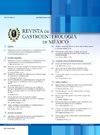Frecuencia de adenomas serrados sésiles en pacientes con antecedente de cáncer colorrectal detectados durante colonoscopias de vigilancia
IF 1.7
Q3 GASTROENTEROLOGY & HEPATOLOGY
引用次数: 0
Abstract
Introduction
Sessile serrated adenomas (SSAs) are precursor lesions of colorectal cancer (CRC) in 15-30% of cases, but due to their subtle characteristics, their endoscopic detection is a challenge. The present work aimed to determine the frequency of SSAs in patients with a history of CRC who underwent index and surveillance colonoscopies after their cancer diagnosis.
Material and methods
An observational cohort study was conducted on patients diagnosed with CRC who underwent an index colonoscopy and at least two surveillance colonoscopies at the Instituto Nacional de Cancerología in Mexico City, between January 2015 and December 2018. Demographic and clinical variables and endoscopic findings were analyzed. SSA frequency was calculated as the number of patients with one or more SSAs divided by the total number of patients analyzed. Means were compared for the bivariate inferential analysis and the chi-square test and Fisher's exact test were used for the nominal variable analysis. Logistic regression was carried out to search for factors related to SSA.
Results
Four hundred patients were included; the mean patient age was 58 years and 52% were women. SSA frequency was 5.25%. Thirty-three percent of the SSAs were found in the index colonoscopy and 38% in subsequent colonoscopies. SSAs had a mean size of 5.52 mm, 84% were classified as Paris Is, 45% as KUDO II, and most were located in the ascending or transverse colon (21% and 20%, respectively).
Conclusions
SSAs are rare premalignant lesions, and their endoscopic diagnosis is a challenge. Their identification during the follow-up of patients with a history of CRC is essential for reducing the risk of metachronous progression.
在结肠镜检查中发现有结肠直肠癌病史的患者中,静坐缝合腺瘤的发生率
无柄锯齿状腺瘤(SSAs)在15-30%的病例中是结直肠癌(CRC)的前体病变,但由于其微妙的特征,其内镜检测是一个挑战。本研究旨在确定有结直肠癌病史的患者在癌症诊断后接受指数和监测结肠镜检查时SSAs的频率。材料和方法在2015年1月至2018年12月期间,在墨西哥城国立医院Cancerología对诊断为结直肠癌的患者进行了一项观察性队列研究,这些患者接受了指数结肠镜检查和至少两次监测结肠镜检查。分析人口统计学和临床变量以及内窥镜检查结果。SSA频率计算为有一个或多个SSA的患者数除以所分析的患者总数。双变量推理分析采用均数比较,名义变量分析采用卡方检验和Fisher精确检验。采用Logistic回归方法寻找与SSA相关的因素。结果共纳入400例患者;患者平均年龄为58岁,52%为女性。SSA频率为5.25%。33%的ssa在第一次结肠镜检查中发现,38%在随后的结肠镜检查中发现。ssa平均大小为5.52 mm, 84%为Paris i型,45%为KUDO II型,多数位于升结肠或横结肠(分别占21%和20%)。结论sssa是一种罕见的恶性前病变,其内镜诊断具有一定的挑战性。在对有结直肠癌病史的患者进行随访时对其进行识别对于降低异时性进展的风险至关重要。
本文章由计算机程序翻译,如有差异,请以英文原文为准。
求助全文
约1分钟内获得全文
求助全文
来源期刊

Revista de Gastroenterologia de Mexico
GASTROENTEROLOGY & HEPATOLOGY-
CiteScore
1.60
自引率
12.50%
发文量
102
审稿时长
12 weeks
期刊介绍:
La Revista de Gastroenterología de México es el órgano oficial de la Asociación Mexicana de Gastroenterología. Sus espacios están abiertos a los miembros de la Asociación como a todo miembro de la comunidad médica que manifieste interés por utilizar este foro para publicar sus trabajos, cumpliendo con las políticas editoriales que a continuación se mencionan. El objetivo principal de la Revista de Gastroenterología de México, es publicar trabajos originales del amplio campo de la gastroenterología, así como proporcionar información actualizada y relevante para el área de la especialidad y áreas afines. Los trabajos científicos incluyen las áreas de Gastroenterología clínica, endoscópica, quirúrgica y pediátrica.
 求助内容:
求助内容: 应助结果提醒方式:
应助结果提醒方式:


